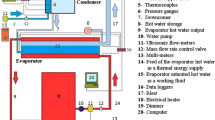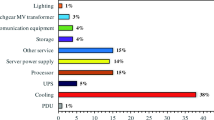Abstract
A computer simulation is performed for a two-phase loop thermosyphon for the B-ISDN telecommunications. The aim of this code development is to provide capabilities to predict the affects of many variables on the performance of the proposed TLT system using different empirical correlations obtained from the literature for the evaporation and condensation, and the shape factors available. In the present study, the simulation code is based on the sectorial thermal resistance network built on the flow regimes of the two-phase flows involved. The nodal resistances are solved by the typical Gauss-Seidal iteration method. The code can predict whether the proposed design is possible based on the flooding limit calculation of the system and its results are compared with the experimental results.
Similar content being viewed by others
Abbreviations
- A :
-
Area (m2)
- A f :
-
Flow area occupied by liquid phase (m2)
- A g :
-
Flow area occupied by vapour phase (m2)
- a :
-
Evaporator thickness (m)
- A x :
-
Cross sectional area (m2)
- b :
-
Evaporator width (m)
- C :
-
Parameter
- C pt :
-
Specific heat of saturated liquid (J/kgK)
- C SF :
-
A constant on Rohsenow’s pool boiling correlation
- D :
-
Outer diameter of tube (m), parameter
- d :
-
linner diameter (m)
- D h :
-
Hydraulic diameter (m)
- F :
-
Frictional parameter
- f :
-
Friction factor
- G :
-
Mass flux (kg/m2s)
- g :
-
Acceleration due to gravity (m2/s)
- H :
-
Specific enthalpy (J/kg)
- h :
-
Heat transfer coefficient (W/m2 K), evaporator depth (m)
- H fluid :
-
Specific enthalpy of fluid (J/kg)
- H f :
-
Specific enthalpy of saturated liquid (J/kg)
- H fg :
-
Latent heat of evaporation (J/kg)
- k :
-
Thermal conductivity (W/m K)
- L :
-
Length (m)
- Nu :
-
Nusselt number
- ΔP a :
-
Acceleration pressure drop
- ΔP f :
-
Frictional pressure drop
- ΔP h :
-
Hydraulic pressure drop
- P :
-
Pressure (Pa)
- (dP/dy) p :
-
Pressure gradient
- Pr :
-
Prandtl number
- Q :
-
Heat transfer rate (W)
- q :
-
Heat flux (W/cm2)
- R :
-
Resistance (K/W)
- r :
-
Radius (m)
- Ra :
-
Rayleigh number
- Re :
-
Reynolds number
- S :
-
Shape factor, defined as eqn. (2)
- T, t :
-
Temperature (°C)
- Δt :
-
Temperature difference between the heater and air (°C)
- TCT :
-
Two-phase closed thermosyphon
- TLT :
-
Two-phase loop thermosyphon
- U T :
-
Overall heat transfer coefficient (W/m2 K)
- ν:
-
Liquid or vapor flow velocity
- W :
-
Mass rate of flow (kg/s)
- WF :
-
Working fluid
- W f :
-
Mass rate of flow of liquid phase (kg/s)
- W g :
-
Mass rate of flow of gas phase (kg/s)
- We :
-
Weber number
- X :
-
Lockhart-Martinelli parameter
- x :
-
Vapor quality
- y :
-
Axis
- a :
-
Acceleration in pressure gradient and pressure drop
- air :
-
Surrounding air
- b :
-
Bulk, boiling, bottom, bended section in Appendix E
- cold :
-
Cold section
- c, cond :
-
Condensation, condenser section
- conv :
-
Convection
- cr :
-
Critical
- ct :
-
Condenser tube
- e :
-
Equivalent
- ev :
-
Evaporation, evaporator
- e 3 :
-
Effective in dry-out region
- ea :
-
Average evaporator
- eb :
-
Average bulk
- esb :
-
Effective subcooling boiling
- ew :
-
Average evaporator wall
- f :
-
Fluid, f is frictional for pressure drop term
- f, tp :
-
Two-phase frictional pressure drop
- do :
-
Dry-out region
- fil :
-
Filler
- g :
-
Gas, vapor state
- h :
-
Heater, hot for Rescb, hydraulic for pressure drop
- hol :
-
Heating section
- i :
-
Inner
- l :
-
Liquid, unit length
- loop :
-
Thermosyphon loop
- lp :
-
Liquid-phase
- max :
-
Maximum
- mis :
-
Miscellaneous
- o :
-
Outer
- pl :
-
Evaporator plate
- s, sat :
-
Saturation
- scb :
-
Subcooled boiling
- T :
-
Total
- t :
-
Tube
- tp :
-
Two-phase
- tr :
-
Transporting section
- v :
-
Vapour
- w :
-
Wall
- α:
-
Void fraction (α=A g/AT)
- γ:
-
Inclination angle (degree)
- δ:
-
Thickness (m)
- η:
-
Efficiency
- θ:
-
Bended angle
- μ:
-
Viscosity (kg/ms)
- ρ:
-
Density (kg/m3)
- σ:
-
Suface tension (N/m)
- ϕ:
-
Diameter
- ψ:
-
Defined in Appendix E
- ζ:
-
Loss coefficient
References
Ali, A. F. M. and McDonald, T. W. 1977, “Thermosyphon Loop Performance Characteristics: Part 2, Simulation Program,”ASHRAE trans., Vol. 83, pt. 2, pp. 260–278.
Bejan, A. 1993,Heat Transfer, John, Wiley & Sons Inc., New York.
Collier, J. G. 1972,Convective Boiling and Condensation, 2nd edition, McGraw-Hill Book Company, New York.
Faghri, A. 1995,Heat Pipe Science and Technology, Taylor & Francis, Washington, DC.
Hewitt, G. F. Shiress G. L. and Bott, T. R. 1994,Process Heat Transfer, CRC Press, London.
Holman, J. P. 1996,Heat Transfer, 8th ed., McGraw-Hill, New York.
Ito, H. 1960, “Pressure Losses in Smooth Pipe Bends,”ASME Trans., Ser. D, Journal of Basic Engineering, vol. 82 (1), No. 13.
Kutateladze, S. S. 1963,Fundamentals of Heat Transfer, Edward Arnold Ltd., New York.
Kishimoto, T. et al., 1994, “Heat Pipe Cooling Technologies for Telecom JMCM’s,”Proceedings of 4th Int. Heat Pipe Symposium, Tsukuba, pp. 132–141.
Lavin J. G. and Young, H. Y. 1956, “Heat Transfer to Evaporating Refrigerants in Two-Phase Flow,”A. I. Ch. E. J, Vol. 11, No. 6, p. 1124.
Mathur, C. D. 1996,A Simulation Program for Multiple Tube-Row Two-Phase Thermosyphon Coil Loop Heat Exchangers, Ph. D Thesis, University of Windsor.
Reid R. C. and Sherwood, T. K. 1966,The Properties of Gases and Liquids, 2th ed., McGraw-Hill, New York.
Rhee B. W. and Young, H. Y. 1974, “Heat Transfer to Boiling Refrigerants Flowing Inside a Plaing Copper Tube,”A. I. Ch. E. Symposium, Series 64.
Rhi, S. H. Kim, W. T. and Lee, Y. 1997, “A Cooling System Using Wickless Heat Pipes for Multichip Modules: Experiment and Analysis”KSME Int. J., Vol. 11 No. 2, pp. 208–220.
Sato T. and Matsumura, H. 1964, “On the Conditions of Incipient Subcooled Boiling and Forced Convection,”JSME, Vol. 7, No. 36, pp. 392–398.
Sieder E. N. and Tate, G. E. 1936, “Heat Transfer and Pressure Drop of Liquids in Tubes,”Industrial and Eng., Chemistry, Vol. 28, No. 12, pp. 1429.
Author information
Authors and Affiliations
Additional information
An erratum to this article is available at http://dx.doi.org/10.1007/BF03186450.
Rights and permissions
About this article
Cite this article
Kim, W.T., Kim, K.S. & Lee, Y. Design of a two-phase loop thermosyphon for telecommunications system (II). KSME International Journal 12, 942–955 (1998). https://doi.org/10.1007/BF02945561
Received:
Issue Date:
DOI: https://doi.org/10.1007/BF02945561




